Learn all about how to forage for mullein and use it in DIY herbal remedies. Mullein leaf, flowers, and roots have many benefits and magical properties that are good for your health and can be used to make herbal smoke blends, easy homemade herbal tea, and more. Mullein should be in every herbalist apothecary. Let’s go foraging for mullein!
Wildcrafting Weeds
If you want to learn more about the edible and medicinal weeds that surround us and how to use them, check out my eBook: Wildcrafting Weeds: 20 Easy to Forage Edible and Medicinal Plants (that might be growing in your backyard)!
Gather & Root Online Foraging Course
My online foraging course is a great way to learn about wild edible and medicinal plants! Learn more about the gather + root online foraging course here.
Foraging Mullein
I love it when a plant that I’ve seen for years, and is totally recognizable to most people, turns out to be a super awesome medicinal.
That’s what it was like for me when I “discovered” plantain, a plant that I’ve seen under my bare feet since childhood. I was totally amazed at what this humble plant that most people deem a “weed” could do.
Then, many years ago, an old hippie friend of mine noticed a large mullein plant growing near where I lived in Yosemite. He mentioned Native Americans and how you could smoke it and I thought it sounded cool, but to be honest, I didn’t really give it a second thought.
But now, as I’ve learned more and more about medicinal herbs over the past few years, I’ve really been amazed about what I’ve learned about mullein. And, luckily for all of us, foraging for mullein is usually quite easy!
Identifying Mullein
Mullein is an extremely recognizable plant once you know what to look for. I’m sure you’ve seen it growing on roadsides or in other disturbed areas.
The most noticeable part of this plant is the tall yellow flower spike that blooms from mid to late summer.
The mullein flower in the picture above was probably two feet taller than me! This is what makes mullein most recognizable in the summertime, but if you look closely in spring you will notice the starts of what will be full grown mullein one day.
A small, fuzzy leaved, rosette of leaves that are close to the ground is how mullein starts its life. It is actually a biennial plant, so it stays like this until the second year of growth when it shoots up the tall flower spike.
Uses for Mullein
That flower spike has a lot of medicinal uses, including being antiseptic, pain relieving and infection fighting properties.
An oil infusion made with mullein flowers has been traditionally used to help treat ear infections.
You can purchase dried mullein flowers from Mountain Rose Herbs if you can’t find any in the wild or if it’s not the right season.
The leaves are super fuzzy and soft and can grow to quite a large size.
They have become somewhat known in the outdoor community as “nature’s toilet paper”. Can’t say that I disagree with that!
The leaves also have a high level of medicinal value.
Mullein leaves are both an antispasmotic and and expectorant. This makes them highly beneficial to the respiratory system as a decongestant and even for asthma.
The leaves can also be used as a poultice for swollen glands, bruises, insect bites and other minor ailments. It would make a good addition to an herbal salve.
Mullein leaves can be dried to use throughout the year. You can also purchase dried mullein leaf from Mountain Rose Herbs.
Because of their respiratory benefits, mullein leaves are often smoked, surprisingly enough, along with other herbs.
The leaves and flowers can also be made into a healing tea.
It’s so nice to have readily available, easy to identify, highly medicinal plants that can be wildcrafted. Mullein has the best of all of these qualities, thankfully!
I don’t know if I’ll be smoking it any time soon, but I will definitely be collecting its leaves and flowers to dry for use throughout winter.
I may even make a mullein infused oil for use in a salve, or even on its own as an ear infection treatment.
I even read that in ancient times when the flower spikes dried up they would be dipped in tallow and used as a torch lantern. There are so many cool uses for this plant!
Medicinal Herbs for Summer Foraging
Keep your eye out for these medicinal herbs on all of your foraging adventures this summer.
Have you ever gone foraging for mullein?

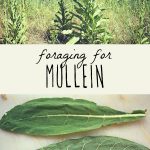
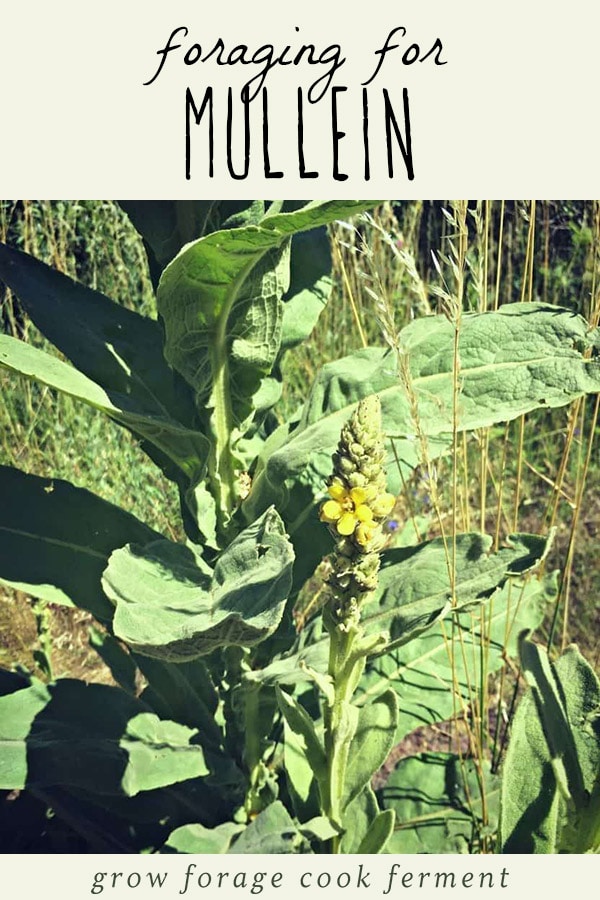
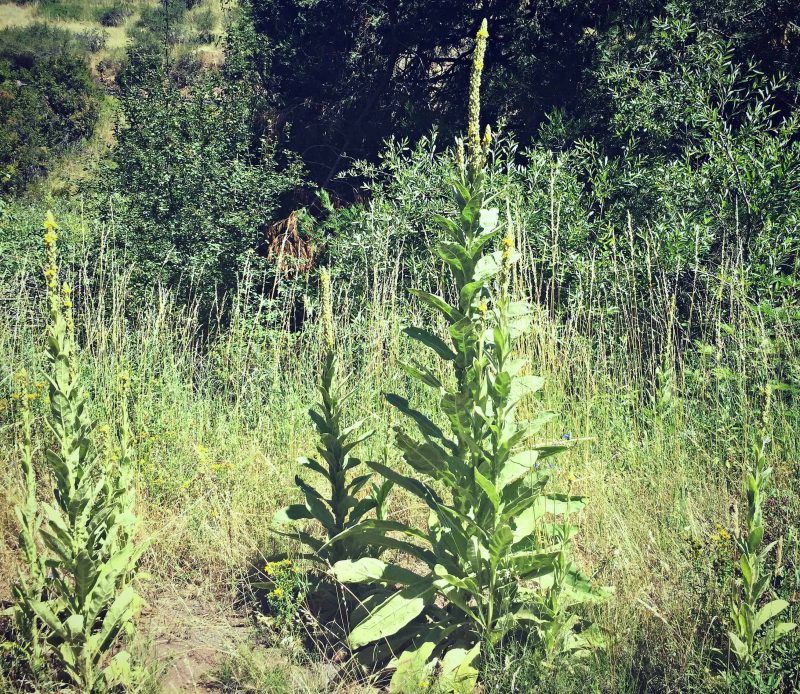
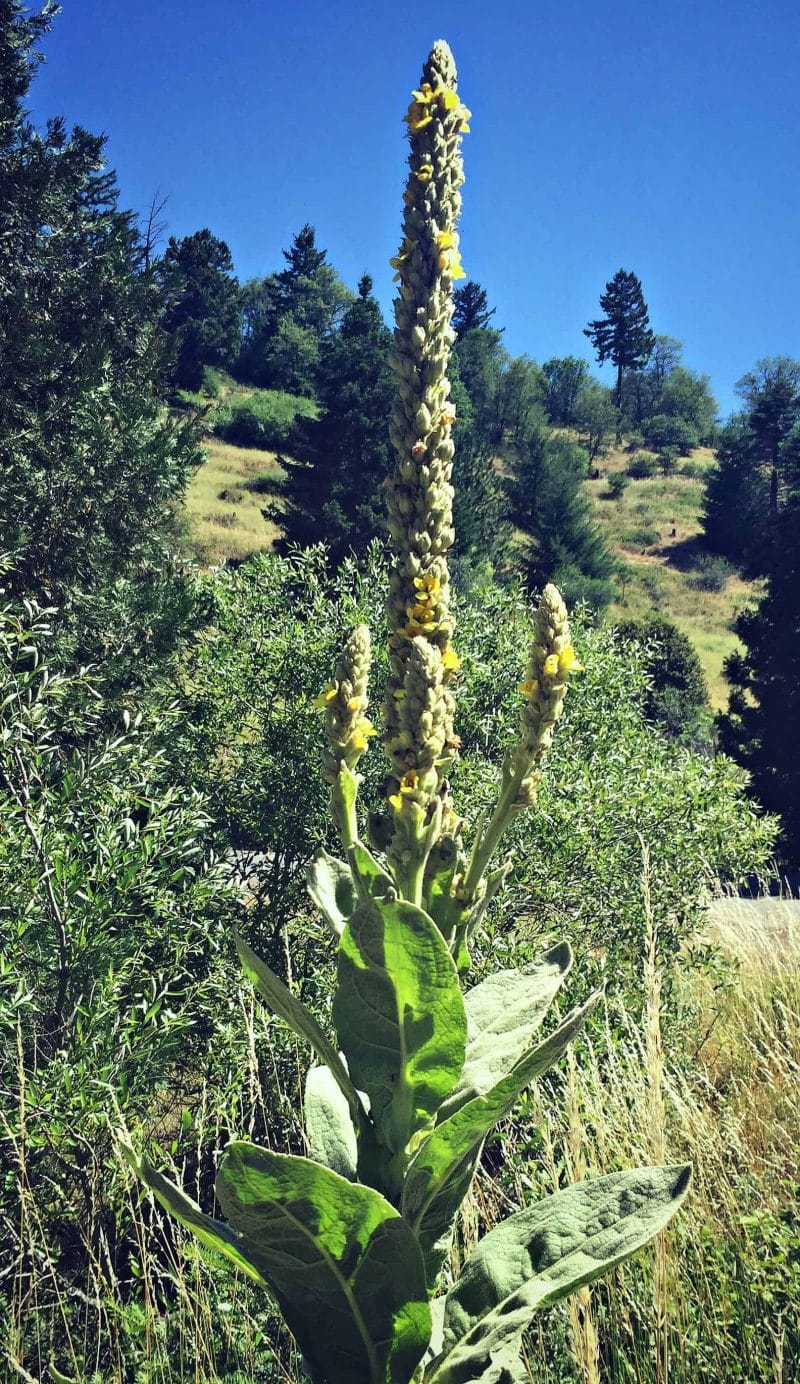
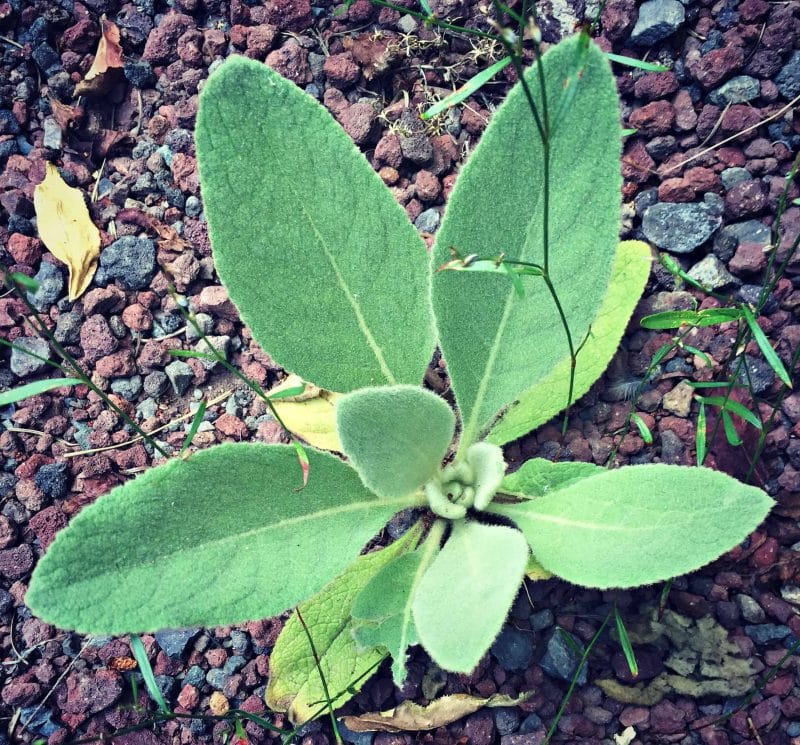
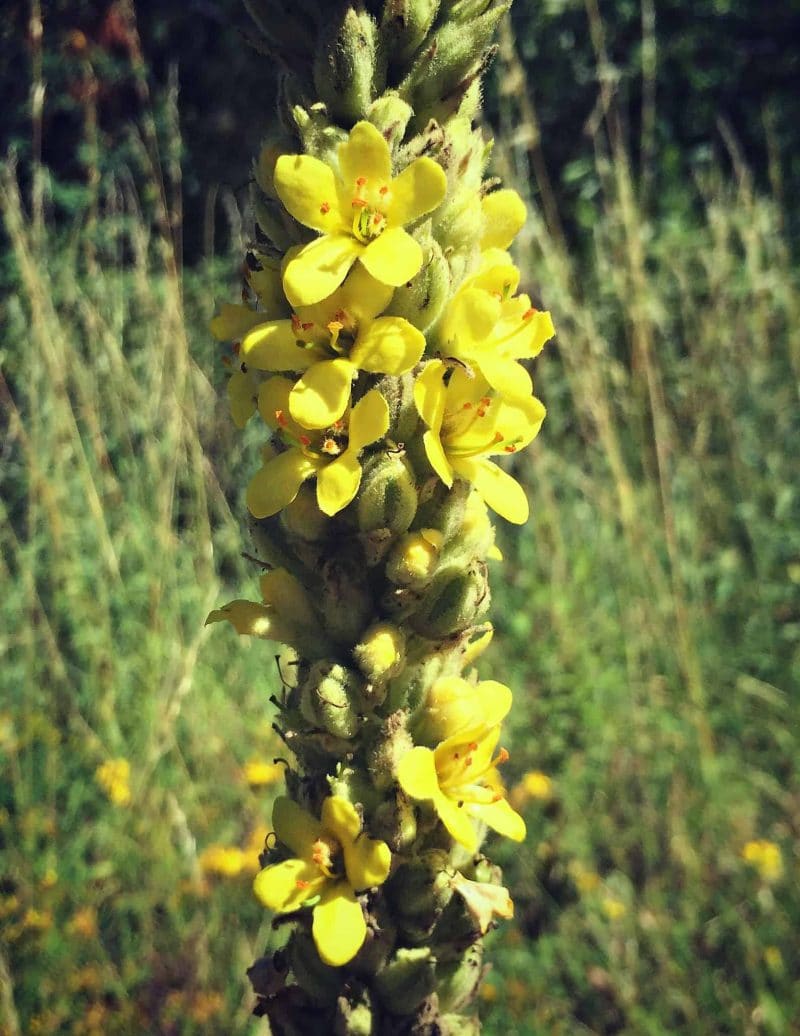
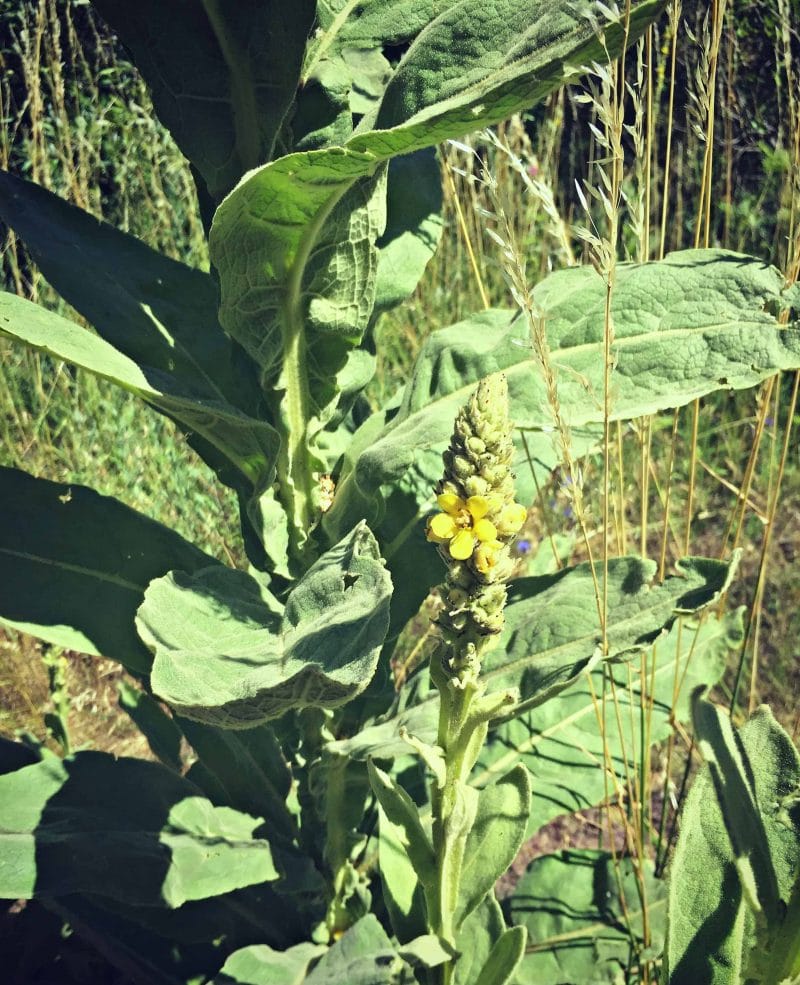
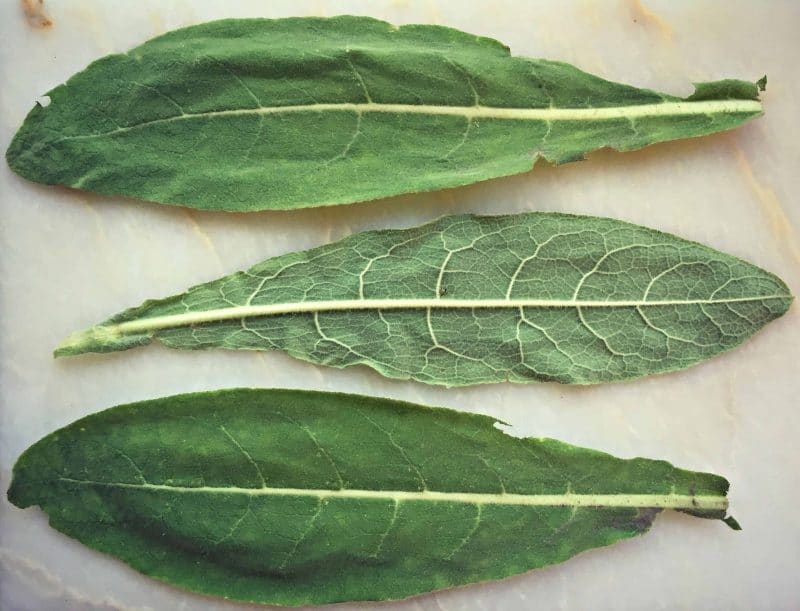
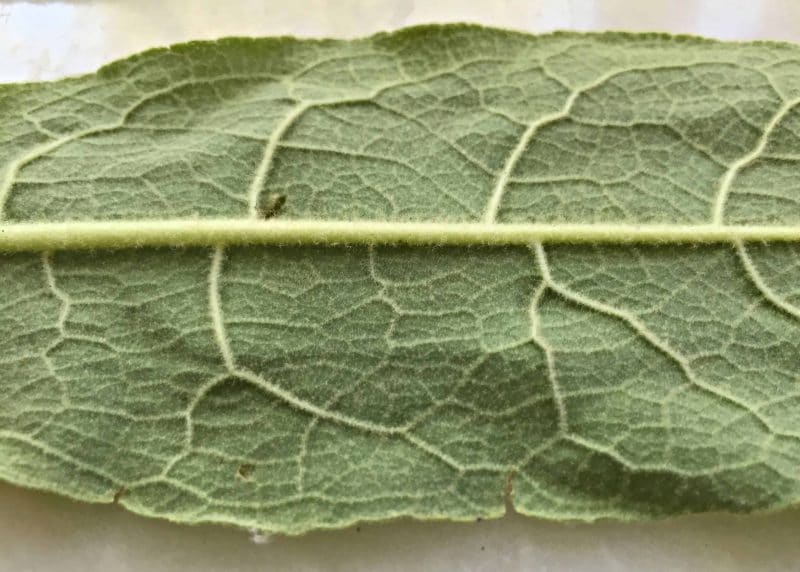
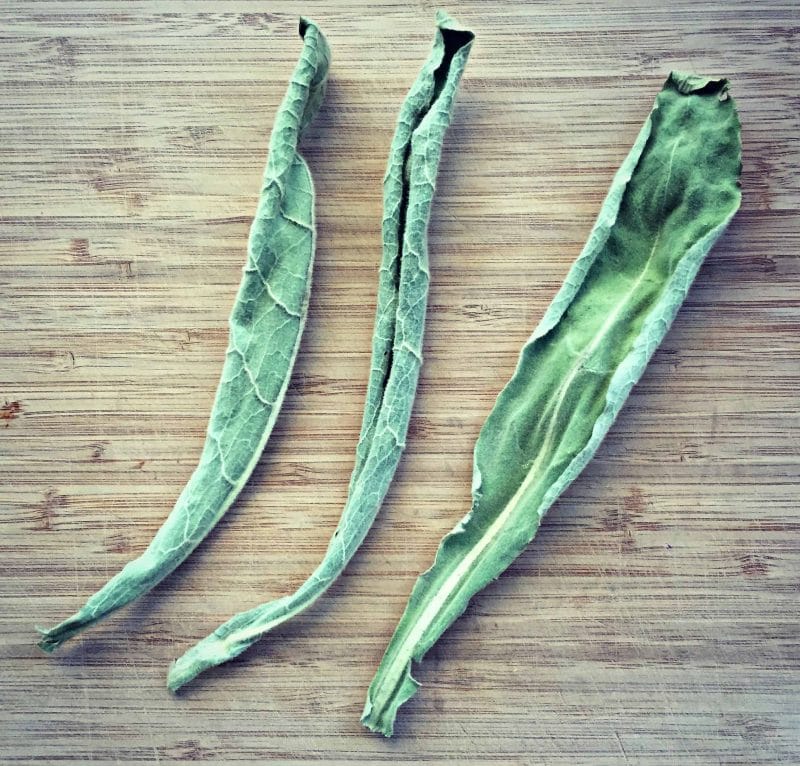
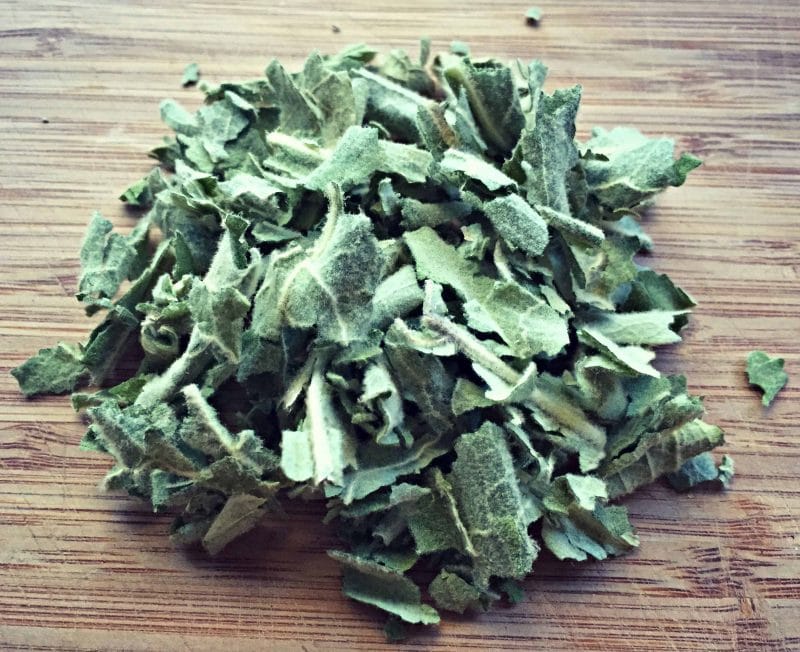

I’m just beginning to look at making some of my own herbal teas and salves and found your post about this plant. I immediately thought: aha! I know that flower! I scrolled through photos on my phone and found several pictures I took several months ago of a stalk of beautiful yellow flowers on the property I live on! So excited! I’ll be watching for it this coming summer.
I have infused the flowers in small amount of evoo for years for earaches for my children and now grandchildren. Better than any Dr. Can prescribe. ❤️
Yes Colleen I have many growing on my land. My children are trying to kill all the weeds so I’m running around trying to save everything that is medicinal before they get the roundup out (I HATE Roundup it’s so scarry). can you tell me if you can feed Mullein to rabbit or chickens? Thanks for all you do, Teresa Hartung
How would u plant some
Dig them up their first growth year and transplant. Get all the root you can. If the plant dies after transplanting just keep the root watered and it should pop back up the following year. Or collect seeds and use them. They may do better planted in fall.
Where I am from, we call these plants, Lambs Ears and are sold as such in gardening centers.
If I remember correctly Mullien is a Biannual therefore flowers in the second year only. Can anyone confirm this?
Actually Lambs Ear is a very different plant. It spreads out rather than growing upright and tall, like a Tobacco plant grows. Also Lambs Ear is a Perennial I do believe and has purplish flowers. The leaves of both plants are shaped and do feel much the same tho!
I am familiar with lamb’s ear and this plant is not the same thing. Mullein is much larger and does not grow as a mat, low to the ground. We had one in our garden last year that was about 8 feet in diameter and at least 12 feet tall. We called it our, “dinosaur plant.”
Every year my property has one mullien pop up somewhere and i always let it grow just to see how big it’ll get. I never knew of it’s medicinal properties until now. Thank you for informing us of the value of this plant.
I had 1 mullien plant last year which I didn’t know what it was. This year I have 8! I look forward to trying out some tea.
Nice to have a reminder on mullin. I made the oil fusion. It takes 6 weeks to make, or thats what i read.. also did mullien root titincture. Never used them unfortunately.
I enjoyed your column very much.I’ve never heard of it.I live in North Alabama.near Florence,do you happen to no if it grows around here?Thanks for all the info.I found it very interesting to hear.I can’t what to hear more from you!
I was hoping you would comment on the safety of using roadside or railside plants. One of my favorite activities while traveling is identifying the plants by the road, where mullein, queen anne’s lace, chicory and many other herbs are found. I do wonder about the toxicity that may be present due to road run-off and exhaust. Could there be a concentration in these plants? Fortunately, I forage in a railyard that has been abandoned for more than 50 years. Heavily forested now, it still harbors those plants that once grew so prolifically when the trains ran daily. I consider those herbs safe, but still look for creosote treated wood ties that hold carcinogens even after decades of weathering. I do not harvest anything near them.
The history and intersection of medicine, magic, and changing religion are a particular study of mine, so the various names of plants are fascinating. At the end of this piece, the use of mullein as a torch is referenced. Among the many names for verbascum thapsus, is hag’s taper. Also of interest: this is not a native American plant. It was brought here from Europe specifically as a medicine.
Good article, good photos!
Now I will go forage some hag’s taper. ;D
i have a plot of mullein started……love it make tea with other herbs …..such a beautiful plant
Just a quick note — if you are drying mullein in your oven (I do this every year) be careful that you have some ventilation in the house because it gets really strong. I forgot that last year and was drying a couple of sheets of it in the oven and started coughing and couldn’t figure out why until I remembered the mullein when the timer dinged. I laughed at myself for being so silly. I KNEW BETTER. Mullein is wonderful for bronchitis, chest colds, or asthma attacks. The tea doesn’t taste bad either. If you add a spoonful of honey to it once it cools down a bit, it’s great and very soothing.
This is one of the most interesting post about this awesome as I thought was a beautiful flower . I am blessed that I live on 76 acres of wildflowers I am just now looking at teas . Thank you .
Before I became a forager and “into” plants, I had a whole bunch of mullein growing behind my house and I pulled it all up!! I hope it comes back.
Just take a flower stalk, break it up and sprinkle where you want it to grow.
My mother read in an old pioneer book about using mullein against plantar warts. she tried it and it has worked. i have quite a few, so i will be trying it next. i think she buys it as an essential oil, tho she says it evaporates quickly like and alcohol based substance.
Mullen is not native to North America, wasn’t introduced to NA until mid 1700’s, and wasn’t wide spread until mid 1800’s plenty of time for Native Americans to adopt it, but it doesn’t have a long history with Native Americans,
love your big beautiful pictures!!!! makes identifying mullein soooo easy!
My husband has asthma so I really appreciate mullein. It grows really easily, too, which is polite of it, I think. Thanks for the great post!
Also, the leaves are best picked when the plant is younger, before it starts putting all its energy to growing it’s flowering stalk, if you are using the leaves for medicinals.
My daughter has had asthma since she was small. Instead of her smoking it, we burn it like you would sage and have her inhale the smoke. Has helped with asthmatic attacks and chest congestion/distress due to various reasons.
It saved my Dad life. He had a big huge mass in his left lung when he was 74 years old. He was a heavy smoker. They wanted to operate on him. He said no. He would drink a cup of tea every morning made from the mullein plant. It took about three month. He started coughing and choking and spitting out all this black tarry junk up. He latterly had to pull strips of it out. He lived to be 89 years old. Still smoking every day
I am a forager and use mullein every winter if congestion comes. Also plantain is a part of my diet every spring and into late summer. I am wondering what would happen if one made an enormous pot (a gallon) of mullein tea and added it to bathwater? In using ginger root in this way I have found it to be a wonderful pain reliever. Has anyone tried this with mullein?
I am new to herbs and I have heard of ginger root, but you use it as a pain reliever my question to you it How!? Can you please explain it to me. Thank You!
Thank you for educating me on what I thought were weeds in my pasture. These are all over the place and I would let them seed for the birds so they had food during the winter season and I would see the horses occasionally eat the tips of the flowering part of the plant. Now the horses and birds have competition=)
Looking for some today. :)
Thanks! I can stop scratching my head on that one! And that’s as I suspected…it would be too easy the other way. ;)
Shauna
You want to pick the individual flowers, not the whole stalk, for the infusion.
I stumbled across your blog tonight while searching for what to do with the cattail shoots my husband brought home. Pickles here we come.
But I have a question about the mullein… I am not new to using herbs, from my garden or foraged, but mullein is new to my “toolbox”. When talking about using the mullein flowers, does one want to actually pick the individual yellow flowers off of the flower stalk, or are we just talking dump the whole stalk into your infusion? (For highest medicinal value) Obviously, it would still be beneficial to use the whole thing, but I’m thinking that by saying “mullein flowers”…the individual little yellow flower is what is really being referred to. Thoughts?
Thanks! Your blog is lovely and extremely informative…I’ll be stalking you forever now. ;)
When I cut mellein, I leave the stalks in a bucket of water overnight…flower heads hanging over a sheet on the ground. This accomplishes 2 things…the flowers fall right off and all the critters leave too. Mullen hosts many insects because of the density in the stalk.
One thing this article does not warn of, but that is important when wildcrafting any herb, is to be certain you are collecting from an area that is not sprayed with herbicide or pesticide.
i started a mullen patch of my own and it is beautiful plus make tea with other herbs twice a week
I had no idea it was so useful! I will have to add this to the list of wild teas I am making! Thank you for the information!
Excellent photos and info on mullein! It’s one of my favorite herbs and gets used every year.
Can’t remember how I found your blog, but I’m enjoying your posts immensely.
Have a great rest of the week!
Great Post! I see those EVERYWHERE where I live. Never knew what they were called or that they could be so useful!
I really like this post, Colleen! I had no idea of all that there is around us that can be so useful in so many ways.